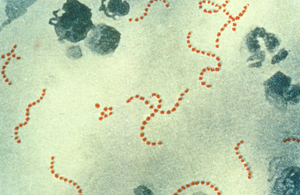Scarlet fever notifications continue to increase
Latest PHE report shows a high number of scarlet fever notifications across England, with 1265 new cases reported in the first 6 weeks of 2015.

Scarlet fever
Steep increases in scarlet fever activity are being seen across the country, with over 300 cases reported last week (2 to 9 February 2015).
Increases in scarlet fever are normal at this time of year as we approach high season between March and April. However, the numbers of cases currently being reported are above what is typical for this time of the year. Whilst this might reflect heightened awareness and improved diagnosis and/or notification practices, the high number of cases currently being notified are of concern. Last year in England, over 14,000 cases of scarlet fever were notified, the highest total since the late 1960s.
Dr Theresa Lamagni, PHE’s head of streptococcal infection surveillance, said:
As we enter into high season for scarlet fever, we ask GPs and other frontline medical staff to be mindful of the current high levels of scarlet fever activity when assessing patients. Prompt notification of cases to local health protection teams is critical to enable local monitoring and rapid response to outbreaks. Schools and nurseries should similarly be mindful of the current elevated levels of scarlet fever and promptly inform local health protection teams at an early stage if they become aware of cases, especially if more than 1 child is affected.
The first symptoms of scarlet fever include a sore throat and fever which may be accompanied by a headache, nausea and vomiting. Between 12 to 48 hours after this, a characteristic fine, sandpapery rash develops, often appearing first on the chest or stomach. Cases are more common in children although adults of all ages can also develop scarlet fever. Individuals who think they or their child may have scarlet fever should consult their GP. Symptoms usually clear up after a week and in the majority of cases remain reasonably mild providing a course of antibiotics is completed to reduce the risk of complications.
As scarlet fever is highly contagious, children or adults diagnosed with scarlet fever are advised to stay at home until at least 24 hours after the start of antibiotic treatment to avoid passing on the infection. For families and friends caring for someone with scarlet fever, the risk of spread can be reduced through frequent hand washing and ensuring clothes, bedding, towels and cutlery are not shared between members of the household.
PHE local health protection teams are on hand to provide authoritative advice and rapid response where outbreaks are detected. We will continue to closely monitor these increases both nationally and locally and work with healthcare professionals and schools to raise awareness and halt the spread of infection.
Background
Scarlet Fever notifications and rate per 100,000 population by PHE Centre in 2014 to 2015 (weeks 01 to 06):
| PHE Centre name | 2013 to 2014 season 2014, weeks 1 to 6 No. cases | Rate | 2014 to 2015, weeks 1 to 6 No. cases | Rate | Rate ratio |
|---|---|---|---|---|---|
| Anglia and Essex | 45 | 1.1 | 53 | 1.3 | 1.2 |
| Avon, Gloucestershire and Wiltshire | 62 | 2.6 | 74 | 3.1 | 1.2 |
| Cheshire and Merseyside | 5 | 0.2 | 97 | 4.0 | 19.4 |
| Cumbria and Lancashire | 28 | 1.4 | 91 | 4.6 | 3.3 |
| Devon, Cornwall and Somerset | 33 | 1.5 | 24 | 1.1 | 0.7 |
| East Midlands | 56 | 1.4 | 135 | 3.5 | 2.4 |
| Greater Manchester | 53 | 2.0 | 40 | 1.5 | 0.8 |
| Kent, Surrey and Sussex | 60 | 1.3 | 84 | 1.8 | 1.4 |
| London | 67 | 0.8 | 115 | 1.4 | 1.7 |
| North East | 64 | 2.5 | 104 | 4.0 | 1.6 |
| South Midlands and Hertfordshire | 42 | 1.6 | 67 | 2.6 | 1.6 |
| Thames Valley | 53 | 2.6 | 48 | 2.3 | 0.9 |
| Wessex | 32 | 1.2 | 57 | 2.1 | 1.8 |
| West Midlands | 67 | 1.2 | 118 | 2.1 | 1.8 |
| Yorkshire and the Humber | 95 | 1.8 | 158 | 3.0 | 1.7 |
| England | 762 | 1.4 | 1265 | 2.4 | 1.7 |
Read latest health protection report.
Further information on Scarlet fever.
Public Health England’s mission is to protect and improve the nation’s health and to address inequalities through working with national and local government, the NHS, industry and the voluntary and community sector. PHE is an operationally autonomous executive agency of the Department of Health.
www.gov.uk/phe Follow us on Twitter @PHE_uk